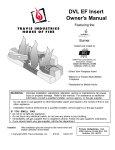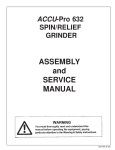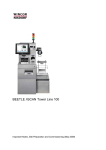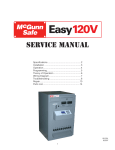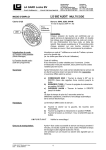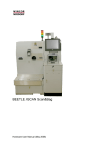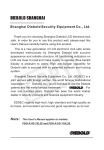Download Troubleshooting
Transcript
Page 1 of 7 Troubleshooting #Use a new Duracell Alkaline or Duracell Procell battery only # Please note that there is no factory override code in any LaGard lock. The security ratings of the locks have been granted on the finding that there is no “back door” method of entry whatsoever if all codes are lost and the door is locked. Batteries Incorrect batteries cause the majority of problems that a service person will encounter. When you insert a new battery, check that it is a Duracell ONLY. Energizer will open some locks, but not others. Heavy Duty Carbon batteries can OPEN CIRCUIT the polyswitch in the lock, and you may have to wait for up to 30 minutes while it resets. On older model locks (pre-Polyswitch) the fuse can blow, and if the door is closed, it will never be opened without drilling. Not all alkaline batteries are reliable, either. It is fairly common to find batteries in stores that are slightly flat from new. To be sure, a service kit should include a voltage meter to test the batteries, or at least a battery that has been used to successfully open another lock. If the red wire of the battery lead on a battery box inside the safe shorts to the lock body, you will never open the lock electronically, and the safe has to be drilled. Lock Signals (Can only be trusted with a good Duracell battery): 1 beep 2 beeps 3 beeps 6 beeps 20 beeps 2 or 3 beeps LED flashes every second LED flashes twice a second LED flashes every 10 seconds Keypad inactive LED staying on 66e only: 3 beeps for any key keypress detected input accepted input not accepted wrong code or faulty (damaged) input pad lock is disabled via alarm box (except Lgbasic and Lgcombo) flat battery VERY flat battery- when the battery is low the electronics will switch off after 2/3 beeps Time Delay (except Lgbasic and Lgcombo) Time Delay finished – enter code again (except Lgbasic and Lgcombo) Time Penalty Time Penalty There is a short in the cable Penalty time Be aware of the time penalty for four incorrect opening attempts – the lock will be inactive for five minutes, during which time it will flash the LED every ten seconds, and stop you from pressing any button or give a triple beep for any key pressed. When the lock wakes up again, it will only allow two attempts before going into penalty time again; and subsequently until the correct number is entered. Page 2 of 7 If the number you are entering is definitely correct and the lock is giving three beeps, try – • Always try an new battery first- incorrect or low powered batteries can cause strange behaviour in the lock • Enter the code very slowly, one number at a time, and ensure that when the lock beeps three times for code not accepted, you are starting another attempt correctly in the cycle. If you rush the entry, you may not realise that as you begin to enter the code, one or two digits have already been entered from the last attempt. The lock will triple beep on the fourth or fifth digit, and if you continue to enter digits while this is happening, you are again out of step with the lock. It will continue to tell you that the number you are entering is incorrect. • If the lock goes into penalty time after four tries, and the five minutes later it awakens for another two tries, the circuit board in the lock is working perfectly. Either the code is incorrect, or the input pad is faulty. (see replacing faulty input pad) • For 33e and 66e pads try pulling off the face plate and getting to the circuit board (see replacing a faulty input pad for instructions on how to remove). Leave all components attached and spray the circuit board with some contact cleaner or Isacol. This will remove any build up on the circuit board that could be causing the numbers to register incorrectly. Put the face place and numbers back on and test. (if this does not work see replacing a faulty input pad) • Find out details of the last battery change or code change the user has performed. Often the customer has caused an error in this process If the input pad is beeping twice on the last digit of the combination but the lock will not open • Immediately enter another digit. If the lock beeps, It is waiting for a second code. If it does not immediately beep, the solenoid has fired and the keys will be dead for 3 seconds. • If the lock is set to Dual Control, open using two known good combinations. Or if you do not have the second code, hopefully you have the master number. With the override tool reprogram the lock with the programmer (3045) • The door mechanism may be putting pressure on the locking bolt. All Lagard locks have a safety feature that prevent the lock from opening when the bolt is being pushed. If the bolt is pressed open while the code is entered, it stays locked. It will not open until pressure is released, during the solenoid-open period (directly after a correct code.) Jiggle the boltwork or pad to make sure there is a small amount of give and never have your hand resting on the handle when opening • The battery may be very flat. It may have enough charge to run the input pad and beeper, but when the solenoid is fired the current is too high and the voltage goes down, putting the lock to sleep. • The lock may be damaged. • Model 66e: The lock may be waiting for a Dallas key to be placed into the socket. To test if the lock requires Dallas keys, try holding down the last digit of any combination. If the lock does not require Dallas keys, you should hear a double beep, followed by another double beep a few seconds later. The LED will stay lit. If the lock does require Dallas keys, the last digit of the combination will double beep; but when held down, it will not double beep again the second time. Another test is to enter the Code, then check to see whether the keypad is dead for ten seconds. If so, it is waiting for a Dallas key. Page 3 of 7 • If both the control code and manager code are known the lock can be set back into pre setup mode through the control menu. (See zapping 66e instructions). After being reset the lock will open on One. Only do this if all other avenues have been exhausted. If the lock is completely dead: The lock may have drained its battery, or it could be in penalty time. Always replace the battery first. Wait about five to ten minutes for the lock to come alive again in case it is in penalty time. If still not responding, check whether there is any recent concrete around the safe. Floor safes are especially likely to have new concrete. If the internal battery is shorted out, or the red wire is shorted to the body of the safe, the safe must be drilled. The gases given off by concrete will destroy any electrical equipment. If the safe is to be concreted into place or filled internally with concrete, make sure the lock is not fitted for at least a week after pouring. Replacing the Input Pad The front face must be removed first, using a flat blade screwdriver or similar tool. Do not lever the panel off. Simply insert the screwdriver in under the face plate, which will release the lugs and the plate will pop off. Page 4 of 7 Fig 1 Releasing the fixing lugs Fig 2 Insertion points for releasing faceplate When the faceplate is removed, be careful not to lose the clear lens for the LED: Fig 3 LED snap-on lens Fig 4 Snap-on lens in place Page 5 of 7 Once the cover is off, remove the rubber numbers and expose the circuit board. The circuit board must be removed very carefully, because there may not be much slack in the cable. Try to get it off the mounting plate, at least far enough to reach in with side cutters. Fig 5 Removing circuit board Fig 6 Cable – cut these one at a time! The cable is soldered to the circuit board as shown above. If you are working on a lock with the battery inside the safe, you must exercise EXTREME CAUTION when cutting the lines to the input pad. If they touch, the fuse in the lock can blow and the safe must be drilled (Note that on later model locks, the fuse has been replaced with a polyswitch. It will “blow” like a fuse, but after a time it will reset.) However if you do not know how old the lock is it must be treated as a fused lock and the wires must not touch. Once the wires are exposed, join them to the wires of a new pad by soldering them and covering each with heat shrink. Page 6 of 7 Another method is using the input pad changing tool shown below: As shown the change tool has four pins, which insert into the holes on the board. The new input pad plugs into the socket on one side before inserting the tool into the board of the faulty pad. The tool is now available with four probes as shown below. The probes are for connecting to input pads that don’t have the holes on the board, such as LG Basic pads. Simply cut the wires coming out of the safe one by one, and strip a little of the insulation off the ends; then join the wires color for color with the probes on the change tool. 4 holes for override tool input Page 7 of 7 Miscellaneous Questions to ask: History – what happened since last time it was opened? Has anybody changed the code or batteries? What brand of batteries was used? (DURACELL preferred) Has anything been spilt on the input pad? Can you see anything foreign in or around the circuit board? Is there anything inside the safe which could have fallen on the cable (if exposed) and pulled it out of the lock? Is the lock in penalty time? Does the lock accept 0-0-0-0-0-0 (double beep) then the customer’s code (double beep)? If 0-0-0-0-0-0 gives a triple beep then something has deposited on the resistances of the input pad and the input pad has to be changed . 0-0-0-0-0-0 has no resistance at all, so if it triple beeps, something has deposited on the board and it is showing a false reading. One usually finds this in kitchens (Restaurants, Kentucky Chicken, Macdonalds, Pizza hut etc) and is a symptom of liquid damage. Coke whisky etc. Can you hear the solenoid firing? If it clicks once and 3 seconds later it clicks again, it is working. If it only clicks once, the battery is very low or the wrong type of battery is being used. Hold a 9 volt Duracell to the snake eyes on the front of the input pad or change the battery if it is in the input pad. If you hear a double beep and the safe does not open, as soon as you have heard the double beep, press another number, and if it beeps, you have a dual control lock (if it is single control and the solenoid has fired, the key pad will be dead for 3 seconds whilst the solenoid is energised.) Enter the code and hold the last digit, if it double beeps twice you have the master code. Connect the 3045 black box to the 33e tool and reprogram the lock to single control. If the solenoid is firing and the lock is not opening, try hitting the safe with a large rubber mallet whilst entering the code… The lock may be screwed tightly down to a warped mounting plate, and the lock body becoming twisted, which can jam the mechanism. If the safe can be opened, try loosening the lock mounting screws to free the swingbolt. Secure the screws with locktie or similar. If the red wire of the battery box shorts to earth, the keypad will be dead, and the battery completely flat, and holding a battery to the snake eyes does not help, You have to drill the Safe. This happens if the installer pinches the cable under something. If you have a 66e and you are getting three beeps from the Dallas key, the Dallas key may be damaged physically or by direct contact with a battery. Delete the Dallas key and reinstall a new one. If you are not sure whether the 66e is set for Dallas key, enter the code and you get a double beep, then enter another number immediately. If the keypad is dead for 10 seconds, the lock was waiting for a Dallas key. If the keypad is dead for 3 seconds it is not waiting for a Dallas key.








